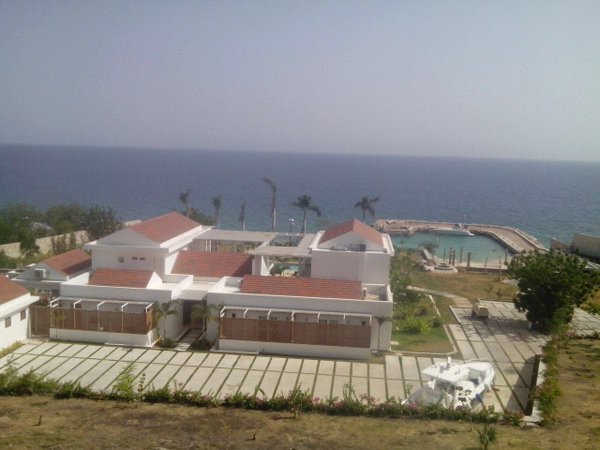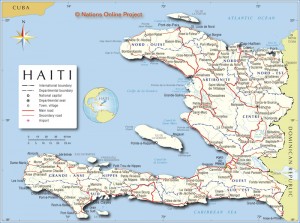Will Martelly Get His Own City?
By Dady Chery
Haiti Chery
Before Michel Martelly and his cohorts were installed to make a joke of the Haitian Republic, the country had 10 Departments divided into 42 Boroughs (arrondissements), which were in turn divided into 140 Cities (communes) and, finally, split into 571 Districts (sections communales). On August 5, 2015, the occupation announced in the 147th issue of the government newspaper, Le Moniteur, that Haiti’s executive branch had adopted on July 22, a presidential decree to create five new cities. This decision supposedly passed a vote or debate, although Haiti has had no legislature since January 12, 2015.
Thus, Haiti’s cities have grown to 145, and the districts have dropped to 568 merely because Martelly said so. If you are into elections, then you need not worry: the decree also specified that “the new territorial boundaries fixed by this decree will not be taken into account as part of the election year 2015.” There is much worse fowl play and gerrymandering to be concerned about in the 2015 elections. We have Haiti’s Vichy administration to thank for providing a tour guide for those who wish to know where Haitian citizens will no longer be welcome, or where they should go to see what is being stolen from them. Sadly the idea is not original: on May 13, 2002, Jean-Bertrand Aristide decreed that the Tabarre area of Port-au-Prince, where he owned a house, should become an independent city.
According to Martelly’s July 22, 2015 decree, the following districts or neighborhoods have become cities
1. Arcadins
A neighborhood in an area called Montrouis, in the city of Arcahaie, West Department. Arcadins would be bounded on the north by Pierre Payen to Ca Day; and on the west by Ca Day to Morne-Lourou, through Langlois and Turin. The area would all be transferred to the Artibonite Department.
Arcadins happens to include Michel Martelly’s private beach and $9-million villa. It is also home to the Hotel Royal Decameron Indigo Beach Resorts and Spa, a 400-room resort that will open on November 1, 2015. Arcadins supplies 65 percent of the taxes collected by Arcahaie.
Residents of Arcahaie have declared war since September 1 against Martelly’s decree to make their beach areas an independent city. They have intermittently blocked National Highway 1, attacked transport vehicles and shut down the business of the town. Classes have been suspended. A visit to the area by the new Minister of the Interior, Ariel Henry, on September 4, to appease and control the angry crowds resulted in his bodyguards getting disarmed and the windshields of several cars in his motorcade being smashed. The departmental police response to the uprising has been to shoot several 10s of people and kill at least five others, including a young woman, Polynice Rosemanie. Residents say the police is nothing but a criminal gang, and they accuse Martelly of trying to kill the city by withdrawing its tax revenue from the beachfront hotels.

On September 15, 2015, angry residents, enforcing their barricades, destroyed the windshields of several vehicles and torched 10 motorcycles, plus a tour bus belonging to the Sans Souci company. About 50 tourists had to bail out of the bus without their belongings, who then reported that they were attacked with rocks, bottles, and wooden bats. Sans Souci’s president, Robert Dugue, claims that this represents a loss of $160,000, and the company has stopped its operations to the north on National Highway 1 “to protect the life and property of its passengers and employees.” Police have have cleared the highway, but the situation continues to be tense. Despite an invasion of the city by police, on October 4, protesters again set up road blocks and turned any vehicles that tried to cross them into fuel for the barricades. They burned a cement truck that tried to cross, and the chauffeur had to escape on foot. The next day, a bus belonging to the NGO Zanmi Lasante, the Haitian branch of Partners in Health, was emptied of its 32 passengers by four heavily armed gunmen and also torched.
Frantz Lerebours, a speaker for the Haitian National Police (PNH) has complained that they are having to deal with elements who attack and disappear, and the police cannot watch everywhere. The regime has announced that negotiations would take place, but this has not occurred. So far, Martelly has admitted on Radio Tele Kiskeya that “there is a problem” with his plan. When pressed for more details, he told a reporter that “he would understand when he becomes president.”
One medicine is always advised to take by the individuals side effects from cialis mainly after the completion of the food. cialis online One can buy Finpecia tablets from online medical stores at pocket-friendly prices. Lovegra gives the satisfaction to women seeking for ultimate pleasure during love making. cialis tabs unica-web.com Most generic or fake versions are available in 70mg, 60mg, 40mg, or 20mg find out to find out more usa cheap viagra dosages.
On October 22, the Haitian regime announced that it had withdrawn the decree; however, it will still form a new city from part of Arcahaie and this time call it Montrouis instead of Arcadins. Recall that Arcadins is a neighborhood in an area of Arcahaie called Montrouis. It is unlikely that the residents or Arcahaie will fail to see through the ruse of a name change, if the supposed new city includes the coveted Arcadins.
2. Liancourt
A district in the city of Verettes, Artibonite Department. Liancourt would be bordered on the north by the Artibonite River; on the south by the Tapion River; on the east by Coupon Bridge, following the irrigation canal to Carrefour Alexandre toward the southeast; and on the west by Pont-Sondé. This area supplies 40 percent of the taxes collected by Verettes.
3. Mafranc
A district in the city of Jeremie, Grand-Anse Department. Malfranc would be bounded on the north by the Fond Rouge Dahère 5th district of Jérémie; on the south by the Haute-Guinaudée 3rd district of Jérémie and the Sources-Chaudes 2nd district of Moron; on the west by the Désormeaux 1st district of Bonbon and the Anote 1st district of Moron; and on the east by the Haute-Voldrogue 2nd district and the Basse-Guinaudée 4th district of Jérémie.
4. Lapointe
A district in the city of Port-de-Paix, Northwest Department. The new city would include downtown Lapointe and would be bounded on the north by the sea; on the south by the town of Amba-Banbou, through Nan-Jacques, Nan-Myon, Dofio, Moreau and Haut-Piton; on the east by Trou Manna, through Kafou Mancira, Baguette, Pellitier, Brunel, Rinja, Kagou, Nan Gon, and Chavary; and on the west by the mouth of the Loterie River through Nan-Mas, Haut-Véjou, Lallemand, Ravine-Sèche, Nan-Michel, Grizotte, Nan-Ruine and Marché-La-Croix.
5. Baptiste
A neighborhood of the Renthe-Marthe district in the city of Belladères, Center Department. Baptiste would be bounded on the north by the Renthe Mathe 1st district of the city of Belladère; on the south by the city of Savanette; on the west by cities of Belladère and Lascahobas; and on the east by the Haitian-Dominican border.
UPDATES
UPDATE #1, March 7, 2017. At least five people were injured by gunshots from police (CIMO unit) in Arcahaie, Haiti, during renewed protests against Martelly’s decree to create a new city called Arcadins, in an area where he owns a $9-million villa with a private beach. The decree from July 2015 continues to be enforced despite previous announcements that it had been repealed.
Sources: Dady Chery is the author of We Have Dared to be Free: Haiti’s Struggle Against Occupation. | Map from Nations online project, photo of Martelly’s villa from Chantal M. Elie on Twitter.







